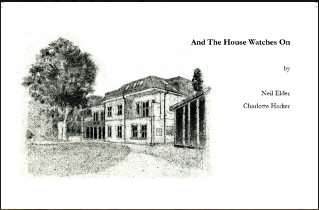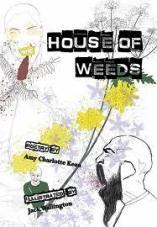Poetry reviews: Louise Warren considers two illustrated collections about houses by Neil Elder and Amy Charlotte Kean
 And The House Watches On
Neil Elder (illustrated by Charlotte Harker)
Cicero Press
£7.99
.
And The House Watches On
Neil Elder (illustrated by Charlotte Harker)
Cicero Press
£7.99
.
.
 House Of Weeds
Amy Charlotte Kean (illustrated by Jack Wallington)
Fly on the wall Press
ISBN-13, 978-1913211158
£8.99
House Of Weeds
Amy Charlotte Kean (illustrated by Jack Wallington)
Fly on the wall Press
ISBN-13, 978-1913211158
£8.99
 Two poetry collections inspired by houses, both illustrated. They are very different in style and content, yet I thoroughly enjoyed both. As the philosopher Gaston Bachelard says in his book Poetics of Space, the house is a world in itself which furnishes us with dispersed images and a body of images at the same time. It is shelter, memory, dream, each room being both personal and universal.
Two poetry collections inspired by houses, both illustrated. They are very different in style and content, yet I thoroughly enjoyed both. As the philosopher Gaston Bachelard says in his book Poetics of Space, the house is a world in itself which furnishes us with dispersed images and a body of images at the same time. It is shelter, memory, dream, each room being both personal and universal.
In his delicate pamphlet The House Watches On, the poet Neil Elder is inspired by West House in Pinner Memorial Park, Middlesex. He has lived nearby for most of his life, and explores the history of the house and grounds, from its beginnings as an affluent family home to becoming a Memorial to the village’s war dead, followed by a shift into disrepair and ruin and then a recent resurrection as hub of activity with a thriving café and gallery dedicated to the artist and inventor Heath Robinson.
Elder’s poems alight on small moments; glimpses of lost lives suddenly reveal themselves like moonlight falling into the corners of an empty room.
When the small hours arrive
the thousand kinds of green that fill the day
are whitewashed into grey.
Shapes, familiar in the light,
become transformed by night.
This is a house that is full of ghosts, memories, emotions : this is a house that is alive.
The house has forgotten more
than we have seen.
The lake, the trees that hide
the spread of Metroland,
the concerts and the fairs,
all appeared or came and went
with West House watching on.
The illustrations by the artist Charlotte Harker (who also lives close to the house) are black and white drawings and monoprints and have the ghostly feel of old photographs. We see the house boarded up and silent, a vase of poppies, a Victorian family staring out, bleached by sun and time, on a hot day in August.
Seeking shade beneath the cypress,
Looking up to Mrs Hogg’s balcony,
Mabel Biggs imagines another life for herself.
But then she remembers
Mrs Hogg has never seen
Miss James topples out of a boat
that dared row
into the middle of the lake.
And Mrs Hogg has never laughed
Until tears came.
I felt a shiver when I read that and looked at the image opposite. This is work that is genuinely haunting.
The same lake appears later in the poem “Ice”, where past and present come together on a cold winter’s day.
Consequences and fear lie dormant
at the bottom of the brain
when you’re nine years old.
Vincent and his mates
Step out onto the ice
and they are Olympic:
inventing a sport, defying laws.
Years later, Vincent walks around the same lake.
He will feel a shudder, feel a chill,
Clasp his son’s hand tightly.
This is the same lake that Miss James toppled into – remember? Can you hear her laughter?
Another haunting poem is “Horatia’s Stillness”.
Everybody knows the lady in black
who sits by beneath the cypress tree.
They understand the broken stillness
Of Mrs Horatia Ward and the reason
why she looks so blankly into the lake for hours.
I won’t give the answer away here!
Elder also shows us glimpses of the house that remembered the dead of the First World War and then became a ruin, that other young men broke into to smoke and drink. Its garden is a hiding place for two children from different times.
The game of hide and seek that Priya plays
is blessed by endless possibility:
When this was Bennetts Park
Pamela played a different hide and seek:
packed tight inside the Anderson
she held her breath in hope and dread
while time refused to pass.
 On the other side of London, the same Blitz appears in Amy Charlotte Kean’s House of Weeds. Here the poet tells us about two unlisted buildings In Peckham, long since gone after being bombed ( with no survivors) . Between 1879 and 1941 they were dwelling houses for 47 displaced individuals, outsiders and rebels. They grew like weeds, wild and unorthodox, but nothing is known of their lives, and all that remains are the wildflowers that appear in this book.
On the other side of London, the same Blitz appears in Amy Charlotte Kean’s House of Weeds. Here the poet tells us about two unlisted buildings In Peckham, long since gone after being bombed ( with no survivors) . Between 1879 and 1941 they were dwelling houses for 47 displaced individuals, outsiders and rebels. They grew like weeds, wild and unorthodox, but nothing is known of their lives, and all that remains are the wildflowers that appear in this book.
A fascinating and intriguing story. But is it true? Kean teases us with a mix of fact and fiction. The poems are all named after the weeds and wildflowers and Kean has personified them, so they appear as part plant, part human. This is energetic, wild, vigorous use of language. Uncompromising and outspoken, Kean gives us glimpses of the inhabitants who once lived in these strange, unfettered houses. The illustrations by Jack Wallington run rampant over the pages, inky outlines with splashes of colour. Flowers become faces and stems emerge from bodies. They interweave with the poems so that word and image become one. Sometimes the shape of the poem embodies the shape of the plant, sprouting from the page low and knotted or tall and thin, as well as in more traditional stanzas or chunks of text, like flash fictions.
I loved “Dipsacus fullonum (Teasel)” for its theatrical ferocity.
Enter, left
a fine tornado
trigger downward towering
teasel; snapping, biting, bristled
teeth of tall unfriendly crowds.
Brazen lines of purple soldiers
moistened trench, those
spineless others, in
savage winds
victorious:
misted
muscles
standing ground.
I am reminded sometimes of Alice Oswald’s poems in her (also illustrated) book Weeds and Wild Flowers. But there is an anger here, a youthful rawness, as in “Allium vineale (Crow Garlic)”.
Is madness real, or is it a look?
A plugged limb and an electrified barnet,
Ice-skating lollipop legs, a souffle of hairy chaos, all thumbs
and squiggles and crowing karaoke to a Gorgonzola moon.
Great big balls of inflorescence like nothing on this planet,
we are all a little mad. It looks lovely.
Or this from “Soleirolia solirolii (Mind Your Own Buisness)”
Damn this brain! This energy. This reluctant calling.
It’s not shyness, per se. Heaven knows what shapes us.
Damn this rudeness, this hardwired nature. Damn Mother Nature!
Damn her delicate green fingers, if fingers are what cast her spells.
Kean can also be gentle and lyrical, channelling the romanticism of Wordsworth, as in “Ranunculus acris ( Meadow Buttercup)”
Bow down, witches
dip thy shiny chins.
This is a love letter, an ode.
A wanton self-expression.
Extend a glove, a carpet,
kiss my lit pyretic beacon.
To the haters, simmer down, drown
Thy sinners in my gene pool.
These are not gentle musings on nature: they are poems that push out of floorboards and pavements, demanding to be seen and to tell their stories.
I shall leave you with this clipping from “Jacobaea Vulgaris (Ragwort)”
Plush and raggy in the meadow’s centre,
Boxed like a gladiator, all hackles and chains.
Ain’t looking for trouble, promise. Ain’t
no deadhead proletariat pocket-watcher.
I won’t kill you, promise.
A poison makes the ending sweeter.
Pick both books and enjoy!
.
Louise Warren
Jun 22 2020
London Grip Poetry Reviews – Neil Elder & Amy Charlotte Kean
Poetry reviews: Louise Warren considers two illustrated collections about houses by Neil Elder and Amy Charlotte Kean
In his delicate pamphlet The House Watches On, the poet Neil Elder is inspired by West House in Pinner Memorial Park, Middlesex. He has lived nearby for most of his life, and explores the history of the house and grounds, from its beginnings as an affluent family home to becoming a Memorial to the village’s war dead, followed by a shift into disrepair and ruin and then a recent resurrection as hub of activity with a thriving café and gallery dedicated to the artist and inventor Heath Robinson.
Elder’s poems alight on small moments; glimpses of lost lives suddenly reveal themselves like moonlight falling into the corners of an empty room.
This is a house that is full of ghosts, memories, emotions : this is a house that is alive.
The illustrations by the artist Charlotte Harker (who also lives close to the house) are black and white drawings and monoprints and have the ghostly feel of old photographs. We see the house boarded up and silent, a vase of poppies, a Victorian family staring out, bleached by sun and time, on a hot day in August.
I felt a shiver when I read that and looked at the image opposite. This is work that is genuinely haunting.
The same lake appears later in the poem “Ice”, where past and present come together on a cold winter’s day.
Years later, Vincent walks around the same lake.
This is the same lake that Miss James toppled into – remember? Can you hear her laughter?
Another haunting poem is “Horatia’s Stillness”.
I won’t give the answer away here!
Elder also shows us glimpses of the house that remembered the dead of the First World War and then became a ruin, that other young men broke into to smoke and drink. Its garden is a hiding place for two children from different times.
A fascinating and intriguing story. But is it true? Kean teases us with a mix of fact and fiction. The poems are all named after the weeds and wildflowers and Kean has personified them, so they appear as part plant, part human. This is energetic, wild, vigorous use of language. Uncompromising and outspoken, Kean gives us glimpses of the inhabitants who once lived in these strange, unfettered houses. The illustrations by Jack Wallington run rampant over the pages, inky outlines with splashes of colour. Flowers become faces and stems emerge from bodies. They interweave with the poems so that word and image become one. Sometimes the shape of the poem embodies the shape of the plant, sprouting from the page low and knotted or tall and thin, as well as in more traditional stanzas or chunks of text, like flash fictions.
I loved “Dipsacus fullonum (Teasel)” for its theatrical ferocity.
I am reminded sometimes of Alice Oswald’s poems in her (also illustrated) book Weeds and Wild Flowers. But there is an anger here, a youthful rawness, as in “Allium vineale (Crow Garlic)”.
Or this from “Soleirolia solirolii (Mind Your Own Buisness)”
Kean can also be gentle and lyrical, channelling the romanticism of Wordsworth, as in “Ranunculus acris ( Meadow Buttercup)”
These are not gentle musings on nature: they are poems that push out of floorboards and pavements, demanding to be seen and to tell their stories.
I shall leave you with this clipping from “Jacobaea Vulgaris (Ragwort)”
Pick both books and enjoy!
.
Louise Warren